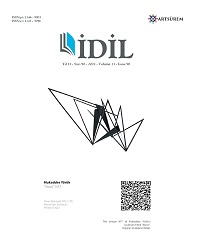ÂŞIK VEYSEL’DE KARA TOPRAK
KARA TOPRAK IN ÂŞIK VEYSEL
Author(s): Deniz Güneş, Can Etili ÖktenSubject(s): Customs / Folklore, Music, Poetry, Turkish Literature
Published by: Sanat ve Dil Araştırmaları Enstitüsü
Keywords: Aşık Veysel; kara toprak; mysticism; local dialect; hançere (larynx) techniques;
Summary/Abstract: Âşık Veysel who is the voice of tolerance in Anatolia, who opened to the world from Sivas within the framework of the tradition of minstrelsy, won the love of all segments of the society with her poems, playing-singing style, spiritual and mystical approach based on love of humanity. Veysel, who at first shied away from reading his own poems and making musical compositions, started to share his poems with the public thanks to the poets and writers he met. In general, the themes of poetry built on nature, all kinds of living and love of humanity, combined with the plain and understandable style in minstrel readings, created a unique style. One of the main points of our work; In the context of musical analysis and vocal performance characteristics, in terms of the structure of the poems and performance techniques (saz-söz), Veysel's place in the traditional structure is discussed from the perspective of a performer. Âşık Veysel is a figure who both writes poems and continues the tradition of playing and singing. Not only he did use the sayings considered sacred within the framework of the society and the religious circle to which he belonged to, in an instructive and advisory manner, but at the same time he brought them forth, as in the meaning of "reaching the Sırr-ı Hakikat" in elements of belief.The clarification of musical expression in the triangle of poetry, vocal and instrumental performance; language use consists of applying larynx techniques in local dialect and vocal performance, as well as dealing with instrumental styles and approaches at the same rate. In this context, when we examine the stanzas of the phrase black soil one by one, we find Veysel's special bond with both Sufism and soil. On the other hand, in his musical performance, we see the diversity of usage of the local dialect, the larynx techniques in vocal performance and all the simplicity of the minstrel style in saz performance. We aimed to combine all these components with ornamentation and larynx techniques, which are used in today's musical notation techniques but were not taken as a basis at the time they were compiled. We studied to reveal the language features in the poetic structure and the poet's point of view on the esoteric-artificial world in the context of black soil.
Journal: İdil Sanat ve Dil Dergisi
- Issue Year: 11/2022
- Issue No: 90
- Page Range: 219-232
- Page Count: 14
- Language: Turkish

